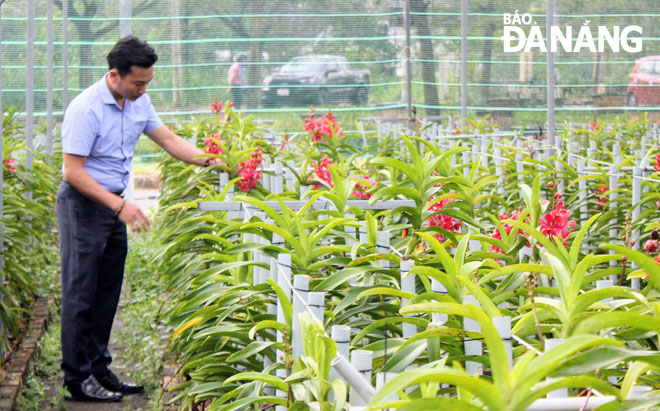Non-indigenous flowers of high economic values grown successfully in Da Nang
Over recent years, varieties of flowers that are not indigenous to Da Nang such as ‘cuc hoa mi’ (pure-white daisies) and Mokara orchids have been successfully cultivated at the Biotechnology Centre located in Hoa Tho Tay Ward, Cam Le District, under the municipal Department of Science and Technology, initially bringing a high economic efficiency, and thus contributing to beautify the city.
 |
| Mr Phan Tien Dung, Head of the Science and Technology Experimental and Service Station taking care of Mokara orchids grown at the Biotechnology Centre |
In the early days of March, a Mokara orchid garden at the Biotechnology Centre is brightened with the red colour of blossoms. Mr Phan Tien Dung, Head of the Science and Technology Experiment and Service Station of the Biotechnology Centre, said Mokara Orchid is a trigeneric hybrid between the Ascocentrum, Vanda and Arachnis Orchids.
Created in Singapore in 1969, Mokara is now as popular as its parents. The first Mokara hybrid was called Mokara Wai Liang, named after C.Y. Mok of Singapore. This hearty hybrid has a unique flower shape and the potential to last up to two or three weeks in the vase with proper care.
Mokara is a Vandaceous orchid. It is important to remember that all Vandaceous orchids are of monopodial growth habit. That is, they grow from the tip or crown of the plant. The inflorescences appear from the axis of the leaves. Flowers are long lasting and appear in a cluster along the spike.
This type of flower has thrived in tropical countries such as Thailand and Singapore. However, most Mokara orchids are transported to Viet Nam by the method of branching cutting. This causes difficulties in ensuring their quality and uniformity.
In 2016, the Biotechnology Centre started to develop a breeding method for Mokara orchids. Through many surveys and tests, by 2019, the Center has identified the environmental factors and suitable methods for propagating this flower, and began to experiment commercial planting. After six months of trial planting , nearly 100% of the plants continued to live, and then 70 - 80% blossomed.
According to Mr Dung, Da Nang boasts sunny weather, suitable for the growing conditions of Mokara orchids. Under these conditions, Mokara orchids can bloom from four to six times a year.
Currently, the Center for Biotechnology has built up a number of models on fully tap the economic potentials of Mokara orchids in Hoa Phuoc Commune, Hoa Vang District.
in late 2019, when the early winter cold spells hit Da Nang, as many as 10,000 plants of ‘cuc hoa mi’ (pure-white daisies) grown on a 300m2 garden at the Biotechnology Centre were in full bloom, attracting a large number of visitors who are eager to admire their beauty and take photos.
‘Cuc hoa mi’, also known as ‘wild daises’ feature fragile white petals covering the yellow pistil. The daisies are also called ‘flower heralding the arrival of winter’ because they spring up in rows in late autumn when the weather becomes cooler.
Different from the flowers with vibrant colours, daisies boast a pristine beauty, bringing lightness and peace to people. The daisies are scientifically named Matricaria Chamomilla, belonging to the Asteraceae family. The season of pure-white daises elapses very quickly, usually lasting only a few weeks.
In Viet Nam, this type of flowers is grown in such localities with cold weather as Ha Noi and Da Lat. People have long viewed the blossoming daisies as a yearly marker that the cold season is just around the corner in these localities. However, when being successfully grown in Da Nang, this type of flower still blooms evenly and beautifully in the spring.
Noticeably, the Biotechnology Centre has completed the production of chrysanthemum varieties using the plant cell technology, initially adapting to the city's climatic conditions.
Despite being grown out of season, but due to the initiative in seed quality, as well as the application of improved techniques, a total of 20,000 chrysanthemums have blossomed for this year’s season with beautiful morphology and the trunk being nearly 20cm higher than those grown in the previous crop.
By PHONG PLAN- Translated by A.T